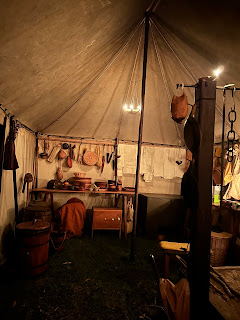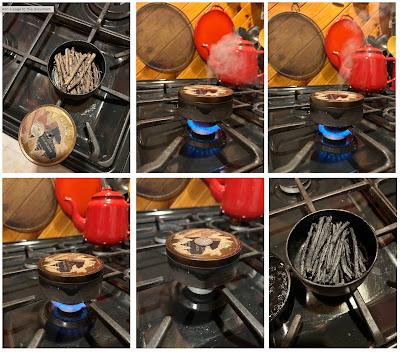...and I've been so busy making things, cleaning things (after our camp-out at AROW - the Abbey Reenactors-Only Weekend, in May), and hunting things down that I've been rather remiss in updating the blog...
Aside from being a lot of fun and giving us the chance to catch up with people, AROW serves a very important function: adding to my To-Do list it lets us set up the encampment after a hiatus of 6-9 months or so and gets all the cries of 'I can't remember how the tent goes up!' 'Where's the cross-pole for the fireplace?!' 'Did we bring any mozzie coils?' etcetera out of the way so that when we set up for the Abbey Festival in July everything goes up smoothly, is washed, mended, restocked, and hopefully we haven' forgotten anything 😉 It also gives us a chance to try out new things - things we've made over the 'break' - to see if they work as expected, or if they're just more junk to cart along because we thought they'd be cool at the time - and new encampment layouts. In previous years we've backed onto the ring road at the Abbey site and been a more-or-less circle of tents on the side of the St Edith's Village area; this year we're going to set up in a semi-circle *facing* the road, because we found at History Alive last year that that configuration chopped about 2 hours off our packdown time (and when you consider that we start packing down about 8am and usually finish about 6-7pm, that extra 2 hours is a bit of a godsend 😉)
I learnt how to do 'looping' earlier this year (looping, or interlooping, or knotless netting, is a precursor to the viking naalbinding and has been around since the Neolithic period) and that developed into starting a pair of socks using Coptic stitch... and then decided to run a class on basic looping at the Abbey Festival... and then decided that we needed more veggie bags... it really is a versatile textile method.
I also decided to put all the assorted bits of the First Aid Kit in a central position - for years the main kit has lived under the foot of my bed - my tent always goes to events, so it was a constant place and everyone knew where it was; the Burns Kit (of course) lived in the kitchen tent, and when we recently did up a Trauma Kit (partly because a couple of our folk are looking at taking up combat again, and partly because we use axes and knives, and partly because we're reenactors and it makes good sense to have one) it occurred to me that having ALL the first aid stuff in a central location would probably be wise... The most central location would be the kitchen tent, but the kits needed to be hidden from public view as they're all rather modern-looking; a (another...) trunk would be ideal but trunks in our period were expensive bits of furniture and what would be appropriate for a kitchen setting would really be more in the way of sacks and baskets...
But...
...a grain ark would be appropriate in the setting 😉! A grain ark is a box/chest/trunk designed to hold grain (!) with a lid that when flipped upside down is the right shape to use as a dough trough (and all the BEST kitchens would have one). I trawled around on the internet and found a few examples and (as usual) took a melange of the lot of them and built one, and it does the job quite nicely 😊
I also made the children an alquerque game (as they get older the wooden toys have less appeal);
and am currently working my way through the updated To-Do list - Rob needs a new banner as the one I made him in 1997 is getting shabby; I need to make/acquire another large kitchen knife and a cleaver; I need to get more mozzie coils, ant spray, olive oil, etcetera; 3 of the table trestles have loose legs which need wedges whacking into them; I need to redo the red paint on the tent roofs as the one we used previously turned out to be fugitive and pretty much washed off at last year's Abbey (which was a week of rain 😢) - this has resulted in orange stripes turning yellow, maroon parts of the valance design turning blue... and the list goes on...
So - if I'm remiss in updating the blog for a while - you'll know why!









































